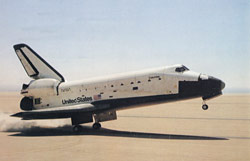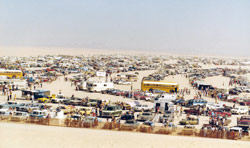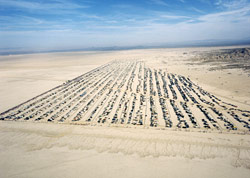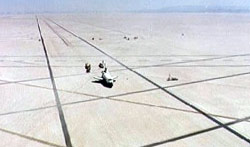- NASA Home
- | Missions
- | Space Shuttle
- | STS-1
Space Shuttle Features
Touchdown! Landing the First Shuttle Mission
04.05.06
 On the morning of April 14, 1981, the space shuttle Columbia approached NASA's Dryden Flight Research Center, Edwards Air Force Base, Calif. With astronauts John Young and Bob Crippen at the controls, the maiden flight of the world's first reusable space vehicle was headed for touchdown, wrapping up the boldest test flight in history.
On the morning of April 14, 1981, the space shuttle Columbia approached NASA's Dryden Flight Research Center, Edwards Air Force Base, Calif. With astronauts John Young and Bob Crippen at the controls, the maiden flight of the world's first reusable space vehicle was headed for touchdown, wrapping up the boldest test flight in history.
Image left: Space Shuttle Columbia's first landing was at NASA's Dryden Flight Research Center, Edwards Air Force Base, Calif. (Photo courtesy of the Edwards AFB History Office) + Larger photo
This radically novel spacecraft would make three more test flights, developing and demonstrating its mission and payload capabilities before going on to fly more than 100 missions in the quarter century since. It would land at Edwards several more times in the decades that followed. But on that spring morning, the first shuttle mission, STS-1, was making history.
Masses of people from up and down the West Coast had started lining up at the base's gates the day before the landing. NASA Dryden, Air Force and industry employee families arrived first and a big campout was on. Tents popped up everywhere. Campfires, bonfires, marshmallows roasting, Bar-B-Qs toasting, the whole thing.
 Image right: Huge crowds flocked to a public viewing site on the east shore of Rogers Dry Lake to watch the first space shuttle landing. (Credit: Edwards AFB History Office) + Larger photo
Image right: Huge crowds flocked to a public viewing site on the east shore of Rogers Dry Lake to watch the first space shuttle landing. (Credit: Edwards AFB History Office) + Larger photo
Joe D'Agostino, shuttle operations support manager at NASA's Dryden Flight Research Center, was there, and he remembers it like it was yesterday.
"In addition to our employees and those of Rockwell, people of the Antelope Valley who saw shuttle Columbia towed down the streets of Lancaster on the way to Dryden for the ferry flight to Kennedy now came out to see it return from space," D'Agostino says. "It was a real personal thing."
At midnight, the Air Force opened the gates, and the general public swarmed into the vast desert air base, headed for an area set aside for public viewing. D'Agostino and others were unsure just how many visitors to expect.
| "The STS-1 landing was a happening!" -- James Young, Historian |
As D'Agostino remembers it, there had "never been so many RVs in one place at one time."
The crowds numbered well over 200,000 people, with some estimates as high as 300,000 visitors who flocked to the lakebed viewing site. Media from around the world added to the throng, as radio and TV trucks of all shapes and sizes rolled in from everywhere.
 Image left: More than 200,000 people witnessed the first space shuttle landing from a 1 1/2-mile-long parking area on the east shore of Rogers Dry
Lake. (Credit: Edwards AFB History Office) + Larger photo
Image left: More than 200,000 people witnessed the first space shuttle landing from a 1 1/2-mile-long parking area on the east shore of Rogers Dry
Lake. (Credit: Edwards AFB History Office) + Larger photo
James Young, Chief Historian of the Air Force Flight Test Center at Edwards AFB, was at one of the viewing sites and remembers the landing well.
"I'll never forget it," he recalled. "My brother-in-law had recently been to the Super Bowl and told me 'it was a happening' when I asked what the experience was like.
"Well," says Young, "the STS-1 landing was a happening!"
"You just had to be there to hear, even feel, the double crack of the sonic boom," Young added. "It was such a tremendous sense of excitement to see something never seen before, to witness such a historic event."
STS-1 was a great success as a test flight, especially considering that it was the first manned American spacecraft flown without a prior unmanned test flight. In also was the first time that solid fuel rockets were used for a U.S. manned launch. However, the spacecraft's first flight performance was above and beyond expectations.
 Image right: Space Shuttle Columbia sits on Rogers Dry Lake following its first landing from space. (Photo courtesy of the Edwards AFB History Office)
Image right: Space Shuttle Columbia sits on Rogers Dry Lake following its first landing from space. (Photo courtesy of the Edwards AFB History Office)
"It was a lot of hard work, but those of us who worked STS-1 took great pride in seeing it return safely from space," D'Agostino said.
As the world watched, STS-1 opened a new era of spaceflight. The flight was not only a great triumph for NASA, it was also an event that enriched the adventurous spirit of Americans and people the world over.
Additional photos of the Shuttle's first landing are at http://www.dfrc.nasa.gov/Gallery/Photo/STS-1/index.html
By Gray Creech
NASA Dryden Public Affairs